| Years in Russia: | 1709 1710 1711 1712 1713 1714 1715 |
| Centuries: | 17th century · 18th century · 19th century |
| Decades: | 1680s 1690s 1700s 1710s 1720s 1730s 1740s |
| Years: | 1709 1710 1711 1712 1713 1714 1715 |

Events from the year 1712 in Russia
| Years in Russia: | 1709 1710 1711 1712 1713 1714 1715 |
| Centuries: | 17th century · 18th century · 19th century |
| Decades: | 1680s 1690s 1700s 1710s 1720s 1730s 1740s |
| Years: | 1709 1710 1711 1712 1713 1714 1715 |

Events from the year 1712 in Russia
| | This section needs expansion. You can help by adding to it. (October 2015) |
| | This section needs expansion. You can help by adding to it. (October 2015) |
| | This section needs expansion. You can help by adding to it. (October 2015) |
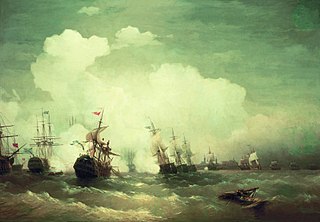
1790 (MDCCXC) was a common year starting on Friday of the Gregorian calendar and a common year starting on Tuesday of the Julian calendar, the 1790th year of the Common Era (CE) and Anno Domini (AD) designations, the 790th year of the 2nd millennium, the 90th year of the 18th century, and the 1st year of the 1790s decade. As of the start of 1790, the Gregorian calendar was 11 days ahead of the Julian calendar, which remained in localized use until 1923.
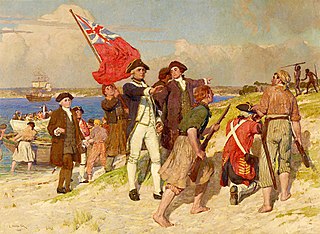
1770 (MDCCLXX) was a common year starting on Monday of the Gregorian calendar and a common year starting on Friday of the Julian calendar, the 1770th year of the Common Era (CE) and Anno Domini (AD) designations, the 770th year of the 2nd millennium, the 70th year of the 18th century, and the 1st year of the 1770s decade. As of the start of 1770, the Gregorian calendar was 11 days ahead of the Julian calendar, which remained in localized use until 1923.

Peter I, commonly known as Peter the Great, was Tsar of all Russia from 1682, and the first Emperor of all Russia from 1721 until his death in 1725. He reigned jointly with his half-brother Ivan V until 1696. From this year, Peter was an absolute monarch who remained the ultimate authority.
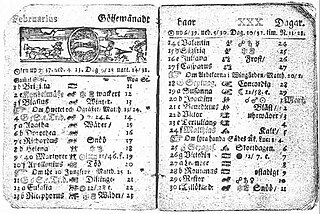
The Swedish calendar or Swedish style was a calendar in use in Sweden and its possessions from 1 March 1700 until 30 February 1712. It was one day ahead of the Julian calendar and ten days behind the Gregorian calendar. Easter was calculated astronomically, with a minor exception, from 1740 to 1844.
Narrative of the Chinese Embassy to the Khan of the Tourgouth Tartars, in the years 1712, 13, 14, and 15 is a record of the travel to Kalmykia, written by Tulišen, a Manchu official who lived in the Qing dynasty.
Black Ruthenia, or Black Rus' (Belarusian: Чорная Русь, romanized: Čornaja Ruś; Lithuanian: Juodoji Rusia; Polish: Ruś Czarna), is a historical region on the Upper Neman, including Novogrudok, Grodno and Slonim. Besides these, other important parts of Black Rus' are Vawkavysk and Białystok. The region was inhabited by the Baltic Yotvingians from ancient times and the name "Black Russia" appeared relatively late.

Yakov Permyakov was a Russian seafarer, explorer, merchant, and Cossack.

The Russo-Ottoman War of 1710–1711, also known as the Pruth River Campaign, was a brief military conflict between the Tsardom of Russia and the Ottoman Empire. The main battle took place during 18-22 July 1711 in the basin of the Pruth river near Stănilești after Tsar Peter I entered the Ottoman vassal Principality of Moldavia, following the Ottoman Empire’s declaration of war on Russia. The ill-prepared 38,000 Russians with 5,000 Moldavians, found themselves surrounded by the Ottoman Army under Grand Vizier Baltacı Mehmet Pasha. After three days of fighting and heavy casualties the Tsar and his army were allowed to withdraw after agreeing to abandon the fortress of Azov and its surrounding territory. The Ottoman victory led to the Treaty of the Pruth which was confirmed by the Treaty of Adrianople.

Vakhtang VI, also known as Vakhtang the Scholar, Vakhtang the Lawgiver and Ḥosaynqolī Khan, was a Georgian monarch of the royal Bagrationi dynasty. He ruled the East Georgian Kingdom of Kartli as a vassal of Safavid Persia from 1716 to 1724. One of the most important and extraordinary statesman of early 18th-century Georgia, he is known as a notable legislator, scholar, critic, translator and poet. His reign was eventually terminated by the Ottoman invasion following the disintegration of Safavid Persia, which forced Vakhtang into exile in the Russian Empire. Vakhtang was unable to get the tsar's support for his kingdom and instead had to permanently stay with his northern neighbors for his own safety. On his way to a diplomatic mission sanctioned by Empress Anna, he fell ill and died in southern Russia in 1737, never reaching Georgia.
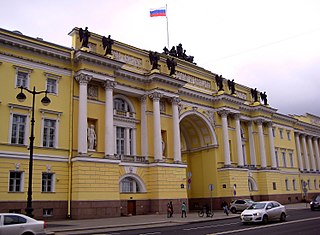
From 1711 to 1917, the Governing Senate was the highest legislative, judicial, and executive body subordinate to the Russian emperors. The senate was instituted by Peter the Great to replace the Boyar Duma and lasted until the very end of the Russian Empire. It was chaired by the Procurator General, who served as the link between the sovereign and the Senate; he acted, in the emperor's own words, as "the sovereign's eye".
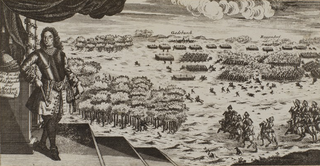
The Battle of Gadebusch or Wakenstädt was Sweden's final great victory in the Great Northern War. It was fought by the Swedes to prevent the loss of the city of Stralsund to Danish and Saxon forces.
Wolmar Anton von Schlippenbach was Governor General of Swedish Estonia from 1704 to 1706.
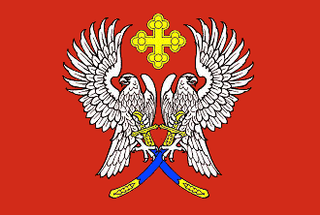
Surovikino is a town and the administrative center of Surovikinsky District in Volgograd Oblast, Russia, located at the confluence of the Chir and Don Rivers, 154 kilometers (96 mi) west of Volgograd, the administrative center of the oblast. Population: 20,533 (2010 Census); 20,338 (2002 Census); 18,336 (1989 Census).

Merkury Vagin was a Russian Arctic explorer.
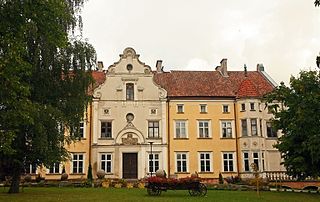
Łabędnik is a village in the administrative district of Gmina Bartoszyce, within Bartoszyce County, Warmian-Masurian Voivodeship, in northern Poland, close to the border with the Kaliningrad Oblast of Russia. It lies approximately 14 kilometres (9 mi) south-east of Bartoszyce and 55 km (34 mi) north-east of the regional capital Olsztyn.

Baltacı Mehmet Pasha was an Ottoman statesman who served as grand vizier of the Ottoman Empire, first from 1704 to 1706 and again in 1710 to 1711, and as Kapudan Pasha in 1704.

Surovikinsky District is an administrative district (raion), one of the thirty-three in Volgograd Oblast, Russia. As a municipal division, it is incorporated as Surovikinsky Municipal District. It is located in the southwest of the oblast. The area of the district is 3,870 square kilometers (1,490 sq mi). Its administrative center is the town of Surovikino. Population: 37,104 (2010 Census); 38,956 ; 38,256 (1989 Census). The population of Surovikino accounts for 55.3% of the district's total population.

The Russian Navy ensign, also known as St. Andrew's flag, was the ensign of the Navy of the Russian Empire, and is the naval ensign of the Russian Federation since 1992, and the banner of the Navy of the Russian Federation since 2000.

Events from the year 1777 in Sweden
Ağa Yusuf Pasha, also known as Gürcü Yusuf Pasha, was an 18th-century Ottoman military leader and Grand vizier.
![]() Media related to 1712 in Russia at Wikimedia Commons
Media related to 1712 in Russia at Wikimedia Commons